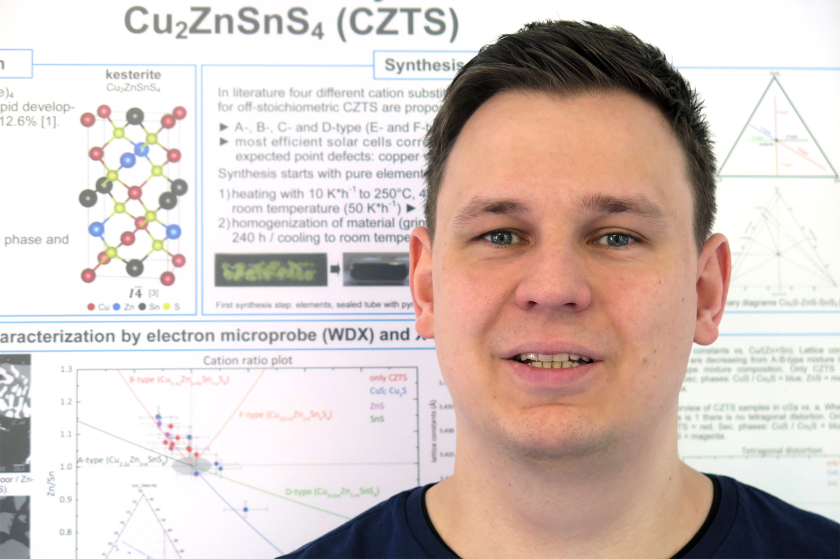Poster award for MatSEC PhD student at the MRS Spring Meeting

At the MRS Spring Meeting in San Francisco, Kai Neldner was awarded for his poster contribution.
The poster contribution of Kai Neldner (HZB-Department Crystallography) was awarded a poster price of the Symposium "Thin-Film Compound Semiconductors" at the MRS Spring Meeting in San Francisco. Kai Neldner, a PhD student in the HZB Graduate School "Materials for Solar Energy Conversion" (MatSEC) has presented results on structural properties of Kesterites (Cu2ZnSnS4 - CZTS) in relation to its stoichiometry deviations.
The best performances of Kesterite-based thin film solar cells with converion efficiencies of 12.6% were obtained with an absorber material quite different from the stoichiometric compound Cu2ZnSn(S,Se)4, especially with a Cu-poor/Zn-rich composition. Because the electronic properties of a semiconductor are strongly related to its crystal structure, it is of great interest to study the nature of stoichiometry deviations systematically and to connect issues such as phase existence limits.
Kai Neldner synthesized off-stoichiometric CZTS powder samples by solid state reaction and studied the structural and chemical properties. He applied different analytical methods using also the HZB's large scale facilities BESSY II and BER II. With his obtained results he was able to prove that CZTS can accomodate deviations from stoichiometry without collapse of the kesterite type structure by the formation of certain point defects. Thus the crystal structure of CZTS can self-adapt to Cu-poor/Zn-rich and Cu-rich/Zn-poor compositions without any structural changes except in terms of the cation distribution.
Susan Schorr
https://www.helmholtz-berlin.de/pubbin/news_seite?nid=14214;sprache=en
- Copy link
-
The twisted nanotubes that tell a story
In collaboration with scientists in Germany, EPFL researchers have demonstrated that the spiral geometry of tiny, twisted magnetic tubes can be leveraged to transmit data based on quasiparticles called magnons, rather than electrons.
-
Ernst Eckhard Koch Prize and Innovation Award on Synchrotron Radiation 2025
At the 27th BESSY@HZB User Meeting, the Friends of HZB honoured the dissertation of Dr Enggar Pramanto Wibowo (Friedrich-Alexander University Erlangen-Nuremberg). The Innovation Award on Synchrotron Radiation 2025 went to Prof. Tim Salditt (Georg-August-University Göttingen) and Professors Danny D. Jonigk and Maximilian Ackermann (both, University Hospital of RWTH Aachen University).
-
Bright prospects for tin perovskite solar cells
Perovskite solar cells are widely regarded as the next generation photovoltaic technology. However, they are not yet stable enough in the long term for widespread commercial use. One reason for this is migrating ions, which cause degradation of the semiconducting material over time. A team from HZB and the University of Potsdam has now investigated the ion density in four different, widely used perovskite compounds and discovered significant differences. Tin perovskite semiconductors produced with an alternative solvent had a particular low ion density — only one tenth that of lead perovskite semiconductors. This suggests that tin-based perovskites could be used to make solar cells that are not only really environmentally friendly but also very stable.
